Every so often, we have an irruption year - when birds that usually spend the winter up in Canada can't find enough food there and come south to Vermont. It looks like the winter of 2020-21 will be such a year!
Northern spruce and pine cone crops were lower than usual, so hungry birds are beginning to show up at feeders and in forests throughout northern Vermont. Here are some of the species that any of us might see at any minute!
Evening Grosbeaks are big, chunky birds with humongous bills (gross beaks). Males are flashy gold and black and white; females are dressed in quiet tan, gray, white, charcoal and palest yellow.
Back in the '80s and early '90s, Evening Grosbeaks used to descend on feeders in groups of twenty or more and polish off 10 or 15 pounds of sunflower seed each visit. Their numbers have declined sharply, making it even more of a treat to see them than in the past.
Some Vermonters are also reporting Pine Grosbeaks: rosy red males and golden females.
Red-breasted Nuthatches, usually much less common than their White-breasted cousins, are visiting Vermont in good numbers too, along with Pine Siskins.
 |
Pine Siskin
|
And there have even been reports of Common Redpolls! Both males and females have the little red "poll" that gave them their name. Males also have red or pink on their breasts.
When redpolls come, they usually come in big numbers! In 2012, well over a hundred enjoyed our feeders for a full week, constantly chattering, flitting and munching.
Sometimes there's one bird in the flock that looks much paler than the rest, as if it was dusted with snow or ice - like the bird in the lower right below. These birds may or not be Hoary Redpolls. A spirited debate has been going on for several years now about whether or not Common and Hoary Redpolls are really two different species and, if so, how to identify Hoaries with any confidence. The consensus seems to be that there's a continuum, with some birds looking "more common-ish" and others "more hoary-ish" - while waiting DNA analysis that will end the debate over species.
In addition to the irruptive birds, many of our regular winter visitors have arrived. Tree Sparrows nest way up on the Canadian tundra and come down here - down south, to balmy Vermont - for the winter months.
Dark-eyed Juncos and White-throated Sparrows, many of which spent the summer on Vermont's highest mountains, have moved downhill for the winter.
 |
White-throated Sparrow
|
 |
Dark-eyed Junco
|
Juncos show an amazing amount of variability in their plumage. Males are usually dark gray or black, females are usually more brownish-gray - but there's a lot of in-betweens! Two of the oddest juncos we've seen at our backyard feeders were this mottled individual:
and this oddity, which was finally identified as a hybrid between a junco and a White-throated Sparrow!
One more possible irruptive species already has Vermont birders excited. Snowy Owls come south in winters when there are more owls on the tundra than there are rodents to feed them. It's mostly immature birds who make the journey, so they're not totally snowy like the adults.
 |
photo by Peter Swaine
|
Snowy Owls usually hang out in open agricultural fields, but they can show up almost anywhere! A few years ago there was one on UVM's Redstone Campus for several days, and the bird below spent more than a week atop rooftops at a new South Burlington development.
This will be a good winter for backyard birding, and maybe for an occasional drive to look for big blotchy owls!
If you'd like to hear more about migration patterns, both "normal" and every now and then, Maeve recently did an interview on Royalton Radio's "Vermont GreenZine" about this topic. The interview starts at about 23:50.
photos by Bernie and Maeve (and one by fellow birder Peter Swaine); text by Maeve
Comment received via email: Special thanks to Maeve Kim and Bernie Paquette for that wonderful link to birds in our neighborhood. The birds are out there and I can watch and listen to them without fear of catching or transmitting The Virus. I feel much less cooped up in my home now that I can look for these beautiful visitors in the wild.
Elizabeth B. Jericho, VT



















Thanks for sharing. Exciting to hear and I look forward to seeing our visitors!
ReplyDeleteGreat to see your post on our Rural Essex Front Porch Forum! Thanks for the good info on birds at your feeders and lovely photos. Sheri Latsen
ReplyDeleteI've seen all the irruptive species except the evening grosbeak which I have not seen in over 35 years when they used to be at my in-laws home in Cambridge in large numbers. Very sad
ReplyDelete